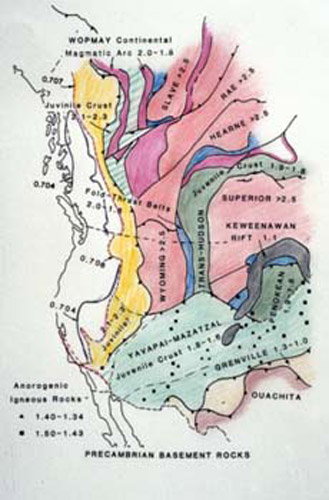lec2photo4.jpg
This image shows the distribution of Precambrian rocks in North America (NA). This means that the rocks are 600 million years old (ma) or more. In the NA Precambrian there are some blocks that are older than 2.5 billion years (by) old. You can also see in this map that there are younger Precambrian strips snaking between the larger blocks. These strips represent the mountain building events that happened as these older continental fragments slammed against one-another. They are now eroded down to a low relief surface, but can be recognized as the suturing together of the larger older continental (aka cratonic) blocks. In the south part of NA you can also see that there are some younger blocks that were added onto NA, and in these blocks you can see interesting places where parts of the blocks are missing. In particular, the western edge of NA seems to have been removed from many of the western Precambrian blocks. In this course we will emphasize how mountains are created through the process of first rifting (or tearing) apart of continents and creating ocean basins, and then fragments closing those basins as continents collide with one another. When we look at the age of the ocean floor across the globe, we see that the oldest oceanic crust that we can find is not much older than 200 million years. But in the continents, we see rocks that are up to 4 billion years old! That is because oceans are transient features that are born and destroyed and they are subducted beneath continents or accreted against their edges. This is a great thing, because that means that the earth’s history is recorded in the continents, not in the oceans…if it were the other way around, it would be tough, wet work doing geology. So, we can see from the way that the Precambrian continent is broken off on the western edge that there was rifting and the development of the passive margin sometime younger than 1 billion years. Image courtesy of Professor Burchfiel.










